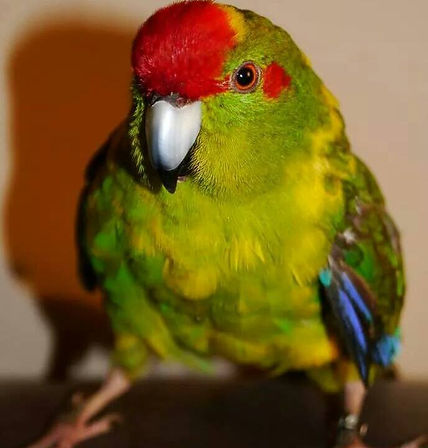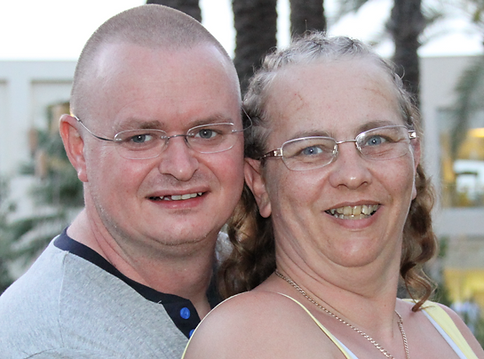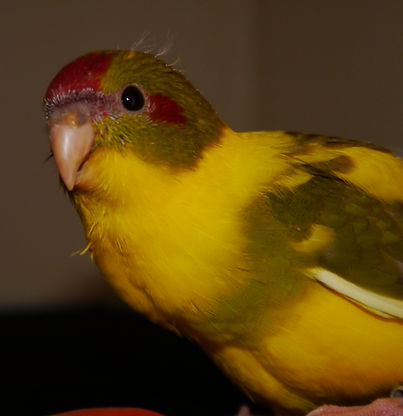
Introduction





Click to join our Facebook Page

Click to the left to contact myself
or to the right to contact Lesley
Myself and My Wife Lesley

Welcome to our page. Our aim is to provide you with as much information as possible, to help you decide and provide the best possible home be it a pet Kakariki or a breeding pair were going to attempt to cover it all here. From keeping it healthy with the right diet, cage, toys, to sexing, breeding and rearing chicks. We hope you enjoy and find this site helpful and if you live in the UK/Ireland we hope you join us on our Facebook page.
If you have found your way here then you have an interest in Kakariki's either as a pet or as an aviary bird. We have both house birds and aviary birds and have a vast knowledge and understanding of both environments. I personally have spent a great amount of time researching and getting to know the species, the good, the bad and the ugly of the New Zealand parrot.
The Kakariki are native to New Zealand. Their lifespan is generally fifteen years. But, most only live half this time due to a Poor diet and cramped living spaces. They are a highly energetic and a fun loving bird, full of curiosity. They love to hide and are the best at finding hidey-holes. There is no controlling the curiosity of this bird. Along with their sense of curiosity comes their love to fly and climb.
Kakariki's are one of the most acrobatic flyers. They love to fly! They can head straight for the wall and within inches of it summersault and come returning right back at you. It is not rare to see them dive under tables, through legs, high, low, up, down and all around...they can do it all. They are wondrous to watch! Given their love of flying it is totally WRONG to clip a Kakariki's wings, if your wanting to do this a Kak is NOT the bird for you!!!!. The bird can even become somewhat depressed from being clipped.
Kakariki's need plenty of time out of the cage for flight, be sure to provide a safe place. Be wary of open doors and windows. Supervision is always necessary!
As for their love of climbing these birds need lots of climbing room, therefore, a very large cage and climbing ladders is essential. They love climbing from one perch to the next.
Aside from their love of flying and climbing nothing pleasures a Kak more than a bath in a dish of water. They will get downright soaked. Be sure not to have the bath session too late in the evening. Kak's are very downy underneath. Although they may look dry on the surface they are not dry underneath, therefore need more than ample time to dry off before the evening cools down.
These go-getters are a perfect house pets as they are not loud and have the most infectious "laugh call". You cannot help but be happy with a Kakariki about.
Due to being a highly energized bird they eat LOTS!, If it is edible, they will eat it, even if it is not edible they will still want to eat it, so please be aware of the household dangers as they will find them. Provide a good supply of fresh fruits, veggies and seed. They are omnivores which means they are both meat and plant eaters so be sure to provide mealworms and chicken even the bone they will break open for the marrow.
"Kak's", as they are lovingly referred to, are not too fond of being handled. Don't get me wrong! They enjoy being with you, but they would prefer not to be cuddled. So if you are desperately seeking physical affection from your new pet it would be best to skip the Kakariki. Both hand reared and parent reared can make good pets given the right environment and time. Hand reared does not mean your going to get a bird sitting looking pretty on you're shoulder it simply means in the case of a Kakariki they are more human friendly and are more likely to socialise with you, again, don't get me wrong they enjoy your company and some will do this for long periods, but most won't. So again think long and hard about a Kakariki being the right pet for you.
Now for a word of caution, Male Kak's can become aggressive from around 4 months of age, this is to do with the hormones kicking in and has nothing at all to do with being hand reared. This normally calms down by about 12 months of age, but as they are terrific breeders they are virtually always hormonal and very territorial, so can still show aggression after 12 months of age when changing water & seed bowls or when you enter their cage environment, and sometimes outside the cage too. This can be a very difficult time for owners and many males are re-homed because of it. Treated correctly with authority and a fearless approach this can be managed quite well but males are not everybody's cup of tea as a pet.
If your in the uk We invite you to join us here on our facebook page for Breeders & Pet Kakariki Owners...
Kakariki Breeders & Pets Uk

Keiko With His Mealworm

Tyson With His Mealworm A Great Source Of Protein Along With Chicken

Keiko Having A Bath, These Birds Absolutely Adore Water And Will Bath Daily

Tyson Back To Himself With Lesley Loving And Enjoying Kisses After His Hormonal Stage

An Example Of Our Hatch Certificate Supplied With All Our Hand Reared Babies
Click to join our Facebook Page
Kakariki can be quite notorious talkers. Tyson does have a good vocabulary, but tends to have periods of just repeating one sentence or word for a while before moving on to his next sentence.


